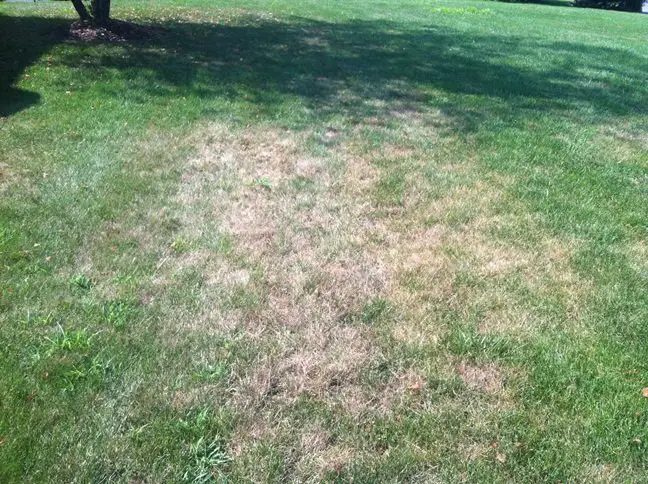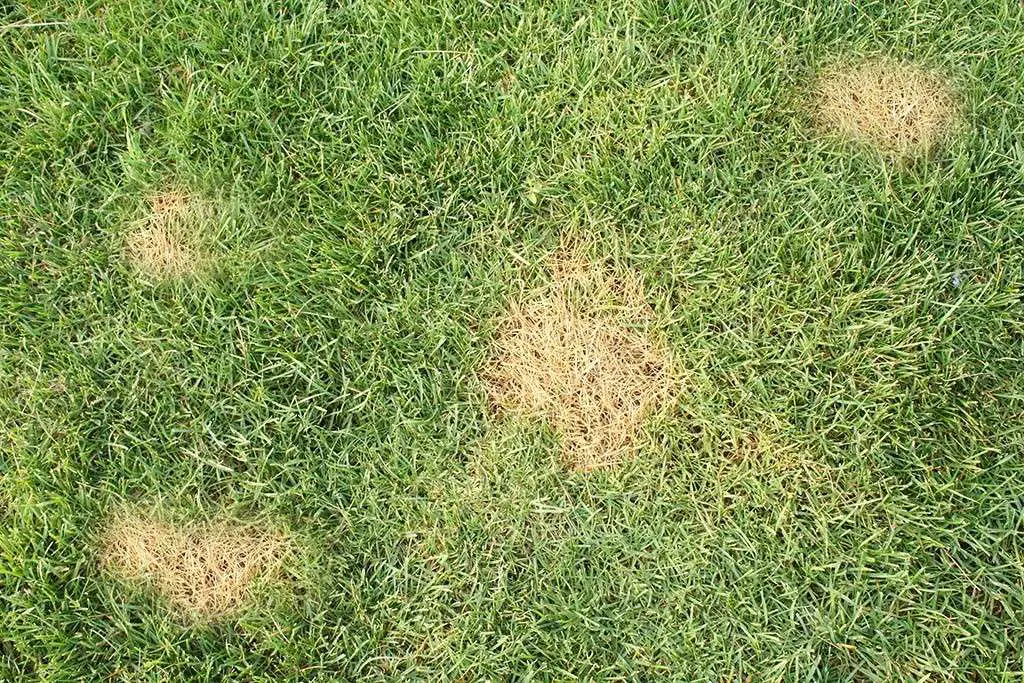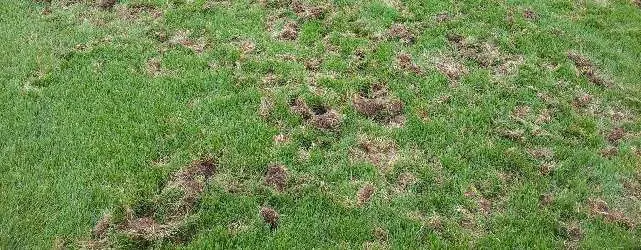Are Grubs Taking Over Your San Francisco Bay Area Yard Were Here To Help
Grubs can do severe damage to your yard. Fortunately, you dont have to accept those brown, dead patches any longer.
Here at Smiths Pest Management, our team knows how to get rid of grubs in Bay Area yards, gardens, and flower beds.
Using traditional and eco-friendly techniques, well solve your grub problem and restore your beautiful, green yard.
Contact us today to schedule your pest control inspection or to request a free quote.
Are There Any Brown Patches In Your Lawn
Have you begun to notice patches of oddly shaped dead spots on your lawn? When your yard is under attack by grubs, grass will thin and turn brown. This leads to visible larger brown patch areas in your yard.
Its common to notice these odd-shaped brown patches in late summer or early fall. During this period, grubs amp up their eating, and the damaged and dead grass becomes more visible.
Many factors can cause brown patches in your yard, like drought or disease. However, if you see brown patches and other signs of grubs, it is likely time to start grub control treatments. Have a pest control company inspect your yard to discover the truth of the issue.
Should I Apply Grubex Before Rain
A very important tip is to water the grub control in within a few days. You can wait for a good rain heading your way, and apply the grub control before the rain. The chemical in some grub controls will break down in hot, dry weather. So if you leave the chemical on your lawn and not watered in, it wont be effective.
Also Check: How To Prevent Racoons From Digging Up Lawn
When Is The Best Time To Treat For Grubs
There are two times to treat for grubs. There is usually a short window in early spring before the grubs get too big and pupate, but it is a narrow window and can be difficult to time properly. The best time to treat is at the end of July to the beginning of August. This is the time of year that the grubs emerge from their eggs and burrow up into the top layer of soil where they eat the roots of the grass. They are easiest to kill in this early stage of development because they are young and near the top of the soil. If you wait too long, in early fall they burrow four to eight inches into the soil to get away from the cold and the treatment cant reach them. They will return older and hardier in the spring and will cause more damage then. You want to get your grub treatment down by the end of July or early August to be the most effective.
How To Get Rid Of Grubs With Chemicals

Although chemicals get the work done faster than natural methods, they can cause some damage to other things in your lawn.
However, if you face a serious grub problem and are short on time, chemicals are the best way to go.
Since we have established that pesticides can harm your lawn, they should only be used if you have a lot of grubs on them.
If the grubs are few, then any of the natural methods listed after this section would suffice. Pesticides are best suited for a grub infestation as they kill these pests almost immediately.
They majorly come in two forms:
- Liquid and
The method of application will depend on what form your pesticide comes in.
Recommended Reading: Craftsman Lawn Mower Oil Filter
Lawn Grubs: What Exactly Are These Icky Creatures
Grubs are the larvae of Japanese beetles, June beetles, chafers, and other beetles.These white, C-shaped grubs have soft squishy bodies with legs near their head. They feed on grass roots and organic matter in the soil, causing sections of grass in the lawn to die. It can happen really fast. One day youre looking out at your healthy lawn, two days later its wiped out entire patches will be brown, dry, and wilted. Why didnt you see it coming? Because lawn grubs are super sneaky. Theyre underground, out of sight, feasting on your lawns tender roots, which kills the grass.
Signs Of Grubs In A Lawn
Thinning grass and patches of dead grass, especially in lawns that are fertilized and well-watered, are some of the first indications of a grub infestation. The patches get bigger over time. If your lawn is infested with grubs, the grass will also be fairly easy to yank out of the soil with a few tugs. Turfgrass weakened by grubs is also more susceptible to drought damage and weeds.
To determine if grubs are behind the demise of your lawn, grab a shovel and peel back a chunk of grass that is 12 inches wide and 12 inches long. Count how many grubs you see. As a general rule, chemical or biological treatment for grubs is only necessary if you count 10 grubs or more per square foot of lawn, according to the Missouri Botanical Garden. Be sure to replace the grass you removed, says the University of New Hampshire Extension.
You May Like: Corn Speedwell Killer
Reseeding After Lawn Grub Treatment
Dead lawn patches should be reseeded. For me, its currently too late in the season. So Ive cleared out most of the patches, treated the lawn with Scotts GrubEx, will also soon spread Winterizer fertilizer and then reseed in the spring. And hopefully, my yard will remain grub free!
This is Sharyns Slant.
Identifying And Dealing With Grubs In Your Lawn
Lawn care can be a very satisfying job and yet a very complex one at the same time. When a seemingly healthy grass lawn starts to develop problems, it can be hard to determine the cause. Lawn health can be compromised by over or under-watering, misuse of fertilizer, lawn disease or a number of other issues. Grubs are one common cause of many grass yard problems. The immature versions of beetles like Japanese beetles and June bugs, grubs live underground and feed on grass roots, causing a lot of problems for a lawn.
If you’re trying to determine how to care for a lawn with symptoms like the ones listed below, you may be dealing with grubs:
- Spongy turf Grubs feed on the grass roots, which can leave patches feeling “spongy” since the turf is not well anchored.
- Dead patches The peak of grub feeding happens in the fall, leaving irregularly shaped dead patches in grub-infested lawns.
- Loose turf Since the roots are eaten away, the grass can be rolled up like a rug. If you are able to roll up a dead or spongy patch easily, check for grubs while it’s up.
- Animals digging up the lawn Grubs make good food for birds, moles and other small creatures. Animals tearing up lawns may find grubs but it’s also possible that they are only looking for worms.
If you are finding ten or more grubs per square foot of grass, it is probably worth treating. There are a few options to choose from, both natural and chemical, depending on you or your client’s preference:
Read Also: Lawn Mowers Ace Hardware
How To Prevent Grubs On Your Lawn
We couldnt agree more with the adage that says prevention is better than cure. If you do not want to start dealing with a grub infestation, you should kill grubs before laying eggs.
How do you do this? First of all, look for adult beetles. These are the insects that would lay eggs on your soil, which would grow to become grubs.
If you can kill these beetles, you can be sure you have set up a control system. You can use natural treatment to kill adult beetles if you dont want to use any insecticide on your grass or garden.
You can even turn this into a fun activity for kids! Show them the beetles and monitor as they squash them.
How Do I Treat For Grubs In My Lawn
After fertilizer and grass seed, grub control products are typically the most prominently displayed and commonly stocked lawn care product at garden centers. For many homeowners, grub control products are an important part of the annual lawn care routine.
More often than not, people are surprised at how much there is to learn about grubs, and how many misconceptions there are about them and the damage they can do to lawns. This blog, accompanying a live video we produced in the field, addresses some of the common questions we get at the UNH Extension Infoline about grubs.
You May Like: Scotts Disease Ex Vs Scotts Fungus Control
What Does Grub Damage Look Like
Grubs focus their feeding around the roots of your grass. If you begin to find that your grass is drying up and dying in patches, as if it’s been burned, you have grubs. You may also begin to find animals and birds come around more often in order to root around in your lawn. This is because they’re hunting for the pesky insects to complete their meal.
Breaking The Japanese Beetles Lifecycle

Breaking the beetles annual lifecycle is key to controlling grubs in your lawn. Understanding their lifecycle will help you identify the best time for treatment and what product to use.
Spring: As the weather warms, grubs migrate upward where they transform into adult beetles.
Summer: Beetles emerge in early-summer and eat plants throughout the garden. They lay their eggs in the lawn and in late-summer, around August, the grubs emerge and begin feeding.
Fall: Larvae will continue to eat and grow fat through mid-fall.
Winter: Grubs move 26 below the soils surface to survive winter.
Read Also: When Is Lawn Mowing Simulator Coming Out
Are Grubs Completely Bad
Even though grubs can ruin your lawn, not all types of grubs are bad.
Surprising, right?
Yes, you might find brown patches and get alarmed but before you eliminate grubs in your lawn, take some time to observe them. If they cause no significant damage, let them be.
Also, if you find out you have 5 or fewer grubs per square foot of your lawn or garden, it means that you dont have a serious problem at hand.
If you have more than 10 grubs per square foot, it means you have to control them, as it could develop into a full-blown infestation.
Grubs would always be on lawns because thats where beetles lay their eggs. But if they are harming your lawn, its time to take them out.
Brown Patches In Your Lawn
As your lawn recovers from the winter chill and spring sees your lawn becoming greener, especially after your spring fertilising, keep an eye out for brown patches that stay brown. You can lift some of the grass in the patched and if lawn grubs are the culprit youll find that the grass will roll up like a carpet, as it has no roots.
Also Check: How To Get Rid Of Corn Speedwell In Lawn
Also Check: Does Aarons Sell Lawn Mowers
How To Treat Lawn Grubs
So how do you fix it? If you suspect you have lawn grubs there are treatments available. There are plenty of pest controls available on the market. Its good to keep in mind that it can take a while to break up the cycle so you want to look for something that is going to remain in the soil, like LSA Grub Guard. Another option is Amgrow Patrol Lawn Pest Control. With other treatments a second application may be necessary.
Are Animals Hanging Out And Feeding In Your Grass
Have you noticed an increase in animal activity in your yard? This could be a sign that animals are attracted to a grub population growing in your yard. Animals such as raccoons, birds, skunks, and armadillos may be spending extra time in your yard to feed on grub worms.
Not only is this a problem because it may indicate a grub issue, but these visiting animals will cause problems of their own. Your turf may take a hard hit as these animals dig and toss dirt to hunt for grubs. You may even notice molehills or tunnels.
Keep an eye on the activity going on in your yard. If these animals and grubs are giving you trouble, it may be time to call a lawn care and pest control company.
Don’t Miss: Rolled Lawn
What Do Grubs Turn Into
The larvae of scarab beetles such as the Japanese beetle and June beetles cause the most damage
White lawn grubs turn into beetles. Generally, the larvae from three types of beetles in the family Scarabaeidae are the grubs that cause the most damage to lawns. These are the Japanese beetle , June beetles , and the European chafer . Scarab beetles can also damage plants, but the grubs cause the most damage to lawns.
After the white subterranean grubs become beetles, they emerge from the soil to continue their lifecycle. The scarab beetles scurry around gardens, eating plant leaves, flowers, and fruits.
How To Know If Ive Got Lawn Grubs
It is important to know the signs of having lawn grubs so that you can identify the problem early and remove these pests sooner rather than later.
Addressing your lawn grub issue promptly will limit the amount of damage they can inflict and the sooner your lawn can look green and lush again.
These pests can be identified by their white, C-shaped bodies, they have an orange coloured head with three legs on either side of the head.
Recommended Reading: Hydro Seed Lowes
Signs Of Grubs In Your Lawn & How To Get Rid Of Them
Grubs are gross. Thats enough to give them the boot, but the squishy little villains feast on your lawns roots, causing whole sections of it to turn brown, wilt, and die.Then they turn into beetles that lay eggs that, oh yay, turn into more grubs.The only thing worse than grubs is, well, more grubs.How do you know if you have lawn grubs?Then, how do you get rid of those grubs?Nows not the time to be squeamish. Lets take a look.
What Do Grubs Look Like

You likely wont see grubs unless you go digging since they live beneath the surface. They are the larvae of Japanese beetles and are white in color with brown heads. Up to one inch in length, they look a bit like caterpillars. Their parents, the adult beetles, deposit their eggs beneath the surface of the soil so when they hatch and turn into grubs, they can use the roots of your turfgrass as food. When these grubs reach adulthood, they no longer look like caterpillars and instead look like beetles with metallic green heads and bodies. The adult beetles will dine on the grass above the surface while their larvae destroy it from below, which is why being proactive and calling your pest control service is so important.
Grubs and their adult parents create a two-front battleground for your grass, and if you dont do something about it, you could have extensive lawn damage. Unfortunately, many homeowners dont realize that the garden-variety beetles they see are actually producing the dreaded lawn grubs. Our experts will help you identify if youve got a grub problem on your hands.
Read Also: Hydroseed Over Existing Lawn
How Natural Predators Kill Lawn Grubs
Biological predators, like birds, raccoons, moles and more, are an option when it comes to grub control for lawns. You can choose to leave your soil exposed to welcome animals to devour the pests. For example, you can use bird feeders to attract birds to your yard to feast on the grubs. But do keep in mind, animals will dig holes in your lawn, which can cause further damage to your yard.
A healthy, well-kept lawn has an abundance of lush, green grass that feels as soft as a plush carpet. If the grass in your lawn starts dying with no obvious cause, you may have a white grub infestation. White grubs feed just below the surface of the soil, and a close look reveals them devouring grass roots. When your lawns grass starts turning brown, look around for signs that white grubs are the source of the problem.
1
Watch your yard for crows, moles, raccoons and skunks. These animals like to eat white grubs, so if you see them often, it is a sign of grub infestation. Moles alone do not indicate the presence of grubs, because they also feed on other insects and earthworms.
2
Look for dying or dead patches of grass in spring, late summer and fall. Patches will look brown and have an irregular shape.
3
4
Use a garden spade to dig up one square foot of sod in your yard. Look for plump, ridged white grubs that curl themselves into a C shape.
References
Do Lawn Grubs Come Out All
Now, if youre looking for grubs on grassroots during winter, you would see no signs of them. This is because most grubs hide during winter.
In normal temperatures, beetles lay grub eggs. These white eggs are one of the signs you have company. They stay on lawns this way all winter till springtime. When spring comes, they hatch into their larvae form and begin to wreak havoc on your grass. Different birds would flock to your lawn too.
Larvae dont just remain as larvae, and they grow into something else: adults. These adults reproduce and lay eggs all over your lawn. There are different kinds of grubs, but generally, they are about 3.5 centimeters long and can be creamish or whitish.
The most common type on lawns is the grub of the Japanese beetle. We will come to the type of grubs in a bit.
Also Check: Do Racoons Dig Holes
